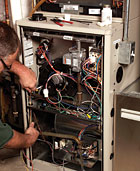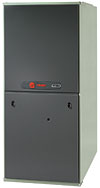
A service technician with Drabek & Hill Inc., Oklahoma City, replaces a panel on a modulating gas furnace. (Courtesy of Johnson Controls Building Efficiency.)
There is no question that the federal tax credits have helped boost the sales of condensing furnaces (equipment over 90 percent AFUE) over the last two years. Sales of condensing furnaces increased to 50 percent of the market in 2009, as homeowners took the opportunity to let Uncle Sam help them replace their existing, inefficient heating systems with high-efficiency units. However, even before the tax credits came into play, sales of condensing furnaces were increasing, and manufacturers expect sales to stay strong even when (if) the tax credits expire at the end of this year.
One reason why consumers may remain interested in condensing furnaces is that energy costs are continually rising, and homeowners are more aware that high-efficiency equipment can lower their utility bills. Another reason may be tied to the recent consensus agreement reached by Air-Conditioning, Heating, Refrigeration Institute (AHRI) and various other industry groups, which would require furnaces sold in the Northern United States to have an efficiency of 90 percent or more by 2013 (neither the Department of Energy nor Congress has agreed to this yet).
Regardless of the reason, manufacturers are understandably happy that their higher-end furnaces are commanding a greater marketshare; however, along with increasing sales come bigger demands from contractors and homeowners. Manufacturers are diligently working to incorporate these demands, which usually include desires for higher efficiencies and more features in a smaller footprint - all of which can be a challenge.
LIFE AFTER TAX CREDITS
Tax credits have definitely had an impact on condensing furnace sales, and after the credits expire there will likely be some degree of a mix shift back to noncondensing furnaces, noted Matt Lattanzi, director of product management, Nordyne. “That said, I don’t think it will be a major decrease. The market was moving in this direction prior to the federal tax credit, because the consumer has a desire for energy savings associated with higher efficiency products. Thanks to the Internet and social media, consumers are becoming more knowledgeable about HVAC products in general. To us, this is a very good thing because homeowners are better prepared to ask the right questions, and those questions lead to the sale of high-efficiency products.”Homeowners are definitely more focused on energy efficiency, lower energy bills and being green, which will continue even if the tax cuts expire, said Nathan Wright, director, product marketing processes and support, Trane. “Homeowners are now looking at their HVAC system as an investment and not just a purchase. Despite the slowdown in the home improvement business during the recession, the market for home energy-efficiency improvements is poised for strong growth. According to Pike Research, a market research and consulting firm, the market for energy-efficient home improvements, including HVAC, nationwide will rise from $38.3 billion last year to $50.2 billion by 2014.”
Although the tax credit program is currently scheduled to expire in December 2010, efforts are underway in Congress to extend the credits or come up with a similar program. “I believe that we will still see some type of program in 2011, probably something along the lines of the proposed Home Star program being considered in Congress,” said Bryan Rocky, product manager, Heating Products North America, Johnson Controls Building Efficiency.
Even if the federal tax credit program expires and is not replaced, there will still be incentives for the consumer/homeowner through utility programs and state weatherization programs, as well as manufacturer rebates for high-efficiency products, noted Rocky. “Add in the constant pressure of higher energy costs, and I think we will see these furnace sales stay strong and continue to dominate the furnace market.”
Bill Stewart, heating products marketing manager, Carrier Corp., would like to see an extension of the tax credit program, as it has helped make higher efficiency systems more affordable for consumers. “We’re hopeful that the tax credit will be extended beyond 2010, but even if it’s not, we expect the migration to more efficient products to continue as a general trend.”

A contractor installs a 95.1% AFUE two-stage, variable-speed gas furnace manufactured by Nordyne. The furnace is just under 35 inches tall. (Courtesy of Nordyne.)
NEW TECHNOLOGIES, SMALLER FOOTPRINTS
Technology has improved over the years, which has resulted in condensing furnaces becoming more reliable and easier to install, which may be additional reasons why sales have increased so dramatically. As Jim Fisher, product manager-gas furnaces, Goodman Global Inc., noted, “We now have an Amana brand primary heat exchanger that has cycled over 2 million times in our reliability laboratory. Because our heat exchanger technology is so strong, we have been able to focus on installation and diagnostic enhancements to our condensing gas furnaces. Any technology that results in easier installation or improved diagnostic reporting is a time-saving and money-making benefit to an installing contractor.”Rheem has also worked diligently to improve its heat exchanger technology, noted Carrol Basham, assistant product manager, Rheem Heating and Cooling. “Heat exchange technologies are being developed that slow the heated air down while it moves through the furnace. This causes a greater amount of heat transfer, resulting in higher AFUE ratings. These technologies combined with new variable-speed inducers will result in furnaces that operate more efficiently for both gas and electrical consumption.”
The evolution of condensing furnaces over the last 20 years has been nothing short of amazing, stated Rocky, as improved technology has resulted in higher efficiencies, better reliability, and new features and control options - in a much smaller footprint. “Consider that the first condensing furnaces made by Johnson Controls were 45 inches tall, required very specific venting, were just barely 90 percent AFUE rated, and seemed like they weighed a ton. While they worked as promised, they were not considered easy to install or service and reliability was average.”

Trane’s XC95m modulating communicating furnace prevents the system from overshooting the set temperature and almost eliminates temperature swings. (Courtesy of Trane.)
The swing in the marketplace to smaller outdoor condensing units that require larger indoor condensing coils in split systems has led to furnace height becoming an issue as it relates to the total indoor height of the system, noted Stewart. “There is significant pressure to reduce the overall system height to allow room for technicians to easily install and service a furnace. However, there is a trade-off between height and serviceability, as well as height versus efficiency. Carrier continues to explore new technologies and apply industry innovations to develop its products for optimal overall indoor height of the system and allow for easy servicing.”
Increasing furnace efficiencies while decreasing the cabinet size has been a challenge, added Lattanzi. “Designing a 97-percent-plus efficient modulating furnace in a 35-inch high cabinet was not an easy task, which is why we invested a lot of time and resources in our heat exchanger design in order to maximize efficiency in as small of a space as possible. Heat exchanger technology is an area that we continue to explore in order to keep improving.”
As noted earlier, the second challenge to designing a small furnace is to make it user friendly. “Contractors, in general, do not have delicate fingers, so we needed to make sure that components are easy to access and service. After we launched our 35-inch furnace line in 2008, we made several rounds of design tweaks based on contractor feedback to really maximize that ease of use,” stated Lattanzi.
Tax credits and new technology have helped drive sales of condensing furnaces to an all-time high, and manufacturers believe this trend will continue. As Wright explained, “Consumers want peace of mind, and they want products and systems that fit their lifestyle and are easy to operate, easy to purchase, and easy to live with. They want reliability. They want comfort. We believe demand will continue to increase for homeowners looking for solutions to keep their children and families healthier, more comfortable, and safer.”
Publication date:11/15/2010


Report Abusive Comment